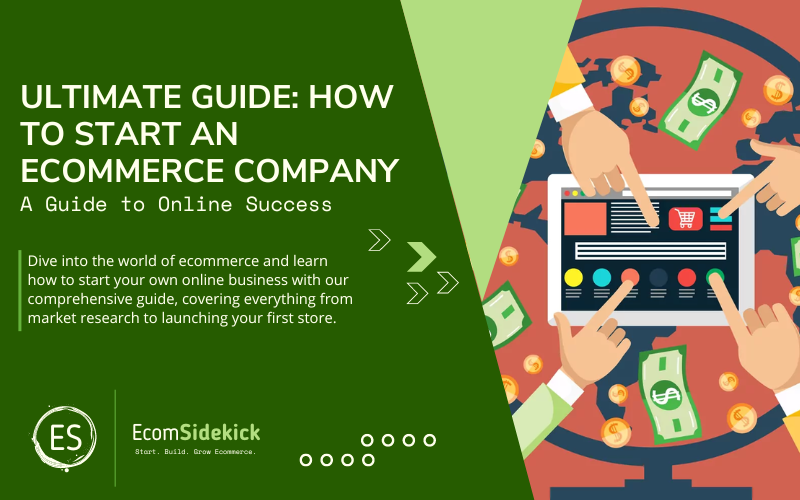Starting your eCommerce journey is straightforward with our detailed guide. From niche selection to legalizing your business, we simplify the process, saving you time and unnecessary costs. Quickly learn how to start an eCommerce company.

- Step 1: Conceptualizing Your Ecommerce Business Idea
- Step 2: Determining Your Ecommerce Business Model
- Step 3: Understanding the Ecommerce Platform Landscape
- Step 4: Choosing a Website Builder
- Step 5: Legalizing Your Business
Step 1: Conceptualizing Your Ecommerce Business Idea
Alright, let’s dig into the very first step of your journey of coming up with your ecommerce business idea. It’s more than just deciding on a product or service.
It’s about sculpting an idea that is rooted in your interests, aligns with market trends, and most importantly, meets your potential customers’ needs. This crucial stage can be navigated smoothly by following these five steps, complete with tools you can use to kickstart your ecommerce journey:
- Fueling Your Idea with Passion: To kick things off, tap into what truly ignites your excitement. This could be a hobby, a topic you can’t stop reading about, or a cause close to your heart. Use mind-mapping tools like MindMeister or Coggle to visually organize your thoughts and zero in on what you’re truly passionate about. Remember, a business rooted in passion is more likely to withstand challenges down the road.
- Performing Market Research: Next, you’ll want to gauge the potential of your idea in the real world. Tools like Google Trends, SEMRush, and Ahrefs can help you keep an eye on trending products or services, and identify potential competition. This research can help you carve out a unique spot for your ecommerce business in the marketplace.
- Identifying Your Target Audience: Who’s going to buy your product or service? Use customer persona tools like HubSpot’s Make My Persona or Xtensio to create a vivid image of your ideal customer. Understanding their needs, preferences, and behaviors will allow you to tailor your product or service to them.
- Solving a Problem: Your ecommerce business should ideally address a real-world problem. Utilize problem-solving frameworks like “Jobs to Be Done” to identify the gap your product or service could fill. If you can clearly articulate the problem your business solves, you’re definitely on the right track.
- Testing Your Idea: Finally, it’s time to validate your business idea. Feedback tools like SurveyMonkey or Google Forms can help you gather opinions from potential customers. If you’re ready, consider launching a minimal viable product (MVP) using a platform like Kickstarter to gauge real-world interest and receive critical feedback.
As you’re well aware, a successful ecommerce business is not just about topping Google search rankings, it’s about making a genuine connection with your customers and providing true value. Sure, we’ll touch on SEO, but your primary focus should be on creating a product or service that meets a real need.
You’re about to embark on an exciting journey, and we’re here every step of the way. So now that you have taken that first step, lets get going on your actual ecommerce business model!
Step 2: Determining Your Ecommerce Business Model
- Traditional Online Retail Store: This is your classic ecommerce business model. You buy inventory at wholesale prices, store it, and sell it at a markup. The biggest perk? Control. You manage every aspect – the products you sell, how you present them, the customer service you provide. However, this control comes with responsibilities. You’ll need to manage inventory, shipping, returns, and customer service, which can be quite the task if you’re a one-man-band.
- Dropshipping: This model is a bit of an ecommerce hack. You sell products, but you don’t keep them in stock or handle shipping. Instead, when a customer buys a product, you purchase it from a third-party supplier who then ships it directly to the customer. This model significantly reduces your upfront costs and inventory risk. However, because you’re not in control of the fulfillment process, it might be harder to ensure product quality and timely delivery.
- Subscription-Based Service: Who doesn’t love a good surprise in their mailbox every month? With the subscription model, customers pay a recurring fee to receive products or services at regular intervals. This model can provide a steady, predictable revenue stream, but it requires you to consistently deliver value and keep your subscribers engaged and satisfied.
- Digital Products: If you’re into selling ebooks, online courses, software, or digital art, this might be your jam. The beauty of digital products is that you create them once and sell them indefinitely – no inventory, no shipping, high profit margins. However, creating a high-quality digital product takes a lot of time and effort, and standing out in the crowded digital market can be quite the challenge.
- Affiliate Marketing: Think of yourself as a middleman. You promote other people’s products and earn a commission for each sale made through your referral. The advantage? You don’t have to deal with creating, storing, or shipping products. The downside? Your income is highly dependent on your ability to drive traffic and convert visitors into buyers.
Remember, your choice of business model should align with your strengths, resources, and the needs of your target audience.
Each model has its strengths and weaknesses, so consider each carefully. And keep in mind that your first choice isn’t set in stone – many successful ecommerce entrepreneurs have pivoted their business model as they’ve grown and evolved.
So stay flexible, open-minded, and ready to adapt as you set sail on your ecommerce adventure!
Step 3: Understanding the Ecommerce Platform Landscape

This is the stage where you’re choosing the online home for your ecommerce business. Just like choosing a physical location for a brick-and-mortar store, this decision can significantly impact your operations, marketing, and growth.
- Self-Hosted Platforms: Think of self-hosted platforms like building your own house from the ground up. They provide maximum control and customization options, but require a certain level of tech savvy (or a good developer on your team). Platforms like WooCommerce and Magento fall into this category. You’ll need to manage hosting, security, and updates yourself, but in return, you get an ecommerce store that’s tailored to your exact needs and specifications.
- Hosted Platforms: Hosted platforms like Shopify or BigCommerce are the equivalent of moving into a ready-made house. You may not get to decide exactly where every wall and window goes, but you don’t have to worry about construction, plumbing, or electrical either. These platforms handle all the technical aspects of running an online store – hosting, security, updates – leaving you free to focus on your products, marketing, and customers. The trade-off? Less customization, and you’ll be working within the parameters of the platform’s design and functionality options.
- Marketplace Platforms: Platforms like Amazon and Etsy are like opening a shop in a bustling mall. They offer a huge built-in audience, and you won’t have to worry about setting up a website. However, competition is fierce, and you’ll have to play by their rules. This can limit your branding and marketing options, and you’ll also be giving up a cut of your sales in fees.
- Social Media Platforms: Social media platforms like Facebook and Instagram now offer ecommerce capabilities, allowing businesses to sell directly to users on the platform. This can be a powerful option if your target demographic spends a lot of time on these platforms, but again, you’ll be playing by their rules, and the analytics and customer data available to you may be limited.
In the end, understanding the ecommerce platform landscape is all about finding the right balance between control, convenience, and exposure. It’s essential to consider your resources, technical capabilities, branding needs, and target audience behavior before deciding on the best fit.
Remember, the platform you choose will be the foundation of your online store or ecommerce setup, so take your time and choose wisely! Now let’s look at website builders.
Step 4: Choosing a Website Builder
This stage is all about finding the perfect tool to build the digital face of your ecommerce business. The right website builder lets you create a beautiful, functional, and user-friendly website even if you don’t know your HTML from your CSS. We’re going to dive deep into the top 5 website builders around, so buckle up!
- Shopify: This is a biggie in the ecommerce world, and for good reason. Shopify offers a user-friendly interface, a host of themes to make your site look professional, and impressive ecommerce features right out of the box. It’s got everything you need to run an online store, from inventory management to payment gateways and more. On the flip side, advanced customization might require knowledge of their own coding language, Liquid.
- WooCommerce: For those of you who are already comfortable with WordPress, WooCommerce is a powerful ecommerce plugin that turns your WordPress site into a fully functional online store. Its open-source nature allows for extensive customization, but it does require a bit more technical knowledge and maintenance compared to some other options.
- Wix: Known for its drag-and-drop design functionality, Wix is a great choice for beginners wanting to design a stunning website without getting into code. Their ecommerce plan comes with plenty of built-in features to get your online store up and running. However, if you plan on scaling up significantly, you might find its ecommerce capabilities a bit limiting.
- Squarespace: With its beautiful, award-winning templates, Squarespace is a favorite among creatives. It’s perfect for showcasing products in the best light. While it has solid ecommerce capabilities, it might not be the best fit if you’re planning on running a large-scale ecommerce store.
- BigCommerce: This platform packs a punch in terms of built-in features and scalability. It’s designed to help larger ecommerce stores manage their operations more efficiently. While it might be overkill for a small shop, it’s ideal for businesses planning to scale fast.
Choosing a website builder is all about understanding your needs, tech skills, and where you see your ecommerce business heading in the future. Whichever you choose, remember that your website is your online storefront – make it a place where customers love to browse, and they’ll keep coming back for more.
A big part of the foundation is making sure that you and your business are protected. So next, we will dive into LLC formation services.
Step 5: Legalizing Your Business

As you’re about to discover, setting up the legal framework for your ecommerce business doesn’t have to feel like learning a foreign language. There are some great online legal platforms out there that can make the process a whole lot easier.
Let’s take a closer look at the top 7 of the best LLC formation service companies:
- NorthWest: Known for its stellar customer service, NorthWest offers affordable LLC formation and registered agent services. They provide thorough assistance in both setting up your LLC and maintaining it to ensure continuous compliance.
- LegalZoom: A one-stop-shop for legal needs, LegalZoom provides a broad spectrum of services including setting up LLCs, corporations, and nonprofits, filing patents and trademarks, and creating legal documents. It also provides access to a network of attorneys for legal advice.
- Rocket Lawyer: Offering services similar to LegalZoom, Rocket Lawyer differentiates itself with a focus on membership perks. These include free document revisions, lawyer consultations, and discounted services.
- Incfile: If you’re specifically aiming to set up an LLC, C-Corp, or S-Corp, Incfile offers free business formation services – you only pay the state filing fees. Their platform is user-friendly and rich in resources to guide you.
- Nolo: Catering to the DIY crowd, Nolo offers an extensive array of online resources, articles, legal forms, and software. From drafting contracts to forming a business entity, Nolo has step-by-step guides and products to help you handle these tasks yourself.
- BizFilings: Standing out with its Learning Center, BizFilings offers comprehensive business incorporation services. Its resources help you understand different business structures, compliance requirements, and tax implications.
- ZenBusiness: ZenBusiness is an affordable platform that offers LLC formation services, operating agreement templates, and worry-free compliance service, simplifying the process of starting and running a business for entrepreneurs.
How to Start an Ecommerce Company: Final Thoughts
When choosing a legal services platform, it’s all about your comfort level and specific needs. Each of these platforms offers something a little different, so take a moment to consider what support you’ll need as you build your ecommerce empire.
Remember, taking care of the legalities might not be the most thrilling part of your journey, but it’s a crucial step towards building a solid, sustainable business.
You’re doing fantastic, keep it up! We’re moving closer to launching that dream ecommerce business of yours.
Frequently Asked Question
How Do I Choose the Right Products to Sell in My Ecommerce Company
Selecting the right products is crucial for your ecommerce company’s success. Consider products with a healthy demand and target market. Look for unique or niche products that set your business apart from competitors. Ensure products have reasonable profit margins and are easy to ship and manage. Conduct market research, analyze competitor offerings, and validate your product ideas before finalizing your product selection.
How Can I Build a Strong Online Presence for My Ecommerce Company?
Building a strong online presence involves various digital marketing efforts. Optimize your website for search engines (SEO) to improve visibility in search results. Leverage content marketing, social media marketing, and email marketing to engage with your target audience. Collaborate with influencers and industry partners to expand your reach. Create valuable and shareable content to establish your ecommerce company as an authority in your niche.
What Are the Best Practices for Managing Inventory and Order Fulfillment in an Ecommerce Company?
Efficient inventory management and order fulfillment are critical for ecommerce success. Utilize inventory management software to track stock levels, restock products, and avoid stockouts. Consider outsourcing fulfillment to third-party logistics (3PL) providers to handle order processing and shipping. Ensure seamless communication with suppliers to maintain inventory availability. Monitor customer orders and shipping status to provide excellent customer service.
Paul Martinez is the founder of EcomSidekick.com. He is an expert in the areas of finance, real estate, eCommerce, traffic and conversion.
Join him on EcomSidekick.com to learn how to improve your financial life and excel in these areas. Before starting this media site, Paul built from scratch and managed two multi-million dollar companies. One in the real estate sector and one in the eCommerce sector.

